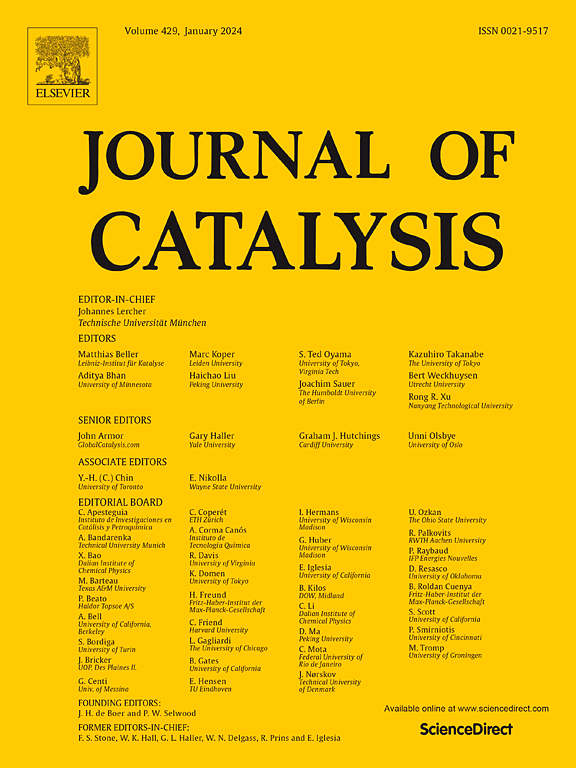Determining site requirements for reactive species in multi-site catalysis on metal surfaces using excluded areas
IF 6.5
1区 化学
Q2 CHEMISTRY, PHYSICAL
引用次数: 0
Abstract
Many metal-catalyzed reactions (e.g., hydrogenolysis, (de)hydrogenation, and hydro-deoxygenation) involve reactive species with molecular volumes that extend beyond the cross-sectional areas of exposed metal atoms. The kinetic behaviors of such reactions are well described by lattice-based models that account for adsorbates occupying multiple adjacent sites (i.e., exposed metal atoms). Site requirements are often inferred from the number of metal atoms an adsorbate coordinates to, which can underpredict the number of contiguous sites that are inaccessible to co-adsorbates by lateral repulsion. Here, we instead determine adsorbate site requirements from the surface areas they exclude from co-adsorbates. These areas are determined from adsorbate structures, optimized previously using density functional theory (DFT), by projecting their molecular volumes onto the surface plane or by tracing their areas with a circular probe that represents co-adsorbates. These excluded areas agree with those inferred from the experimentally measured saturation coverages of eight polyatomic adsorbates on Pt(1 1 1) and Ni(1 1 1). They predict a number of sites needed for ethane hydrogenolysis on Ir nanoparticles (two to three exposed Ir atoms) that is consistent with previous kinetic measurements and DFT calculations. The areas further estimate site requirements for benzene hydrogenation on Pt nanoparticles (six exposed Pt atoms) which accurately describes rate dependences on benzene pressure, under physically realistic benzene and H-adatom coverages, and with adsorption enthalpies consistent with experimental benchmarks. Excluded areas therefore offer a practical and accurate way to determine site requirements in multi-site kinetic models, facilitating mechanistic studies and guiding ab initio catalyst design for reactions of bulky molecules that inevitably cover multiple contiguous surface atoms.


使用排除区域确定金属表面多位点催化反应物质的位置要求
许多金属催化反应(如氢解、(脱)氢化和氢脱氧)涉及分子体积超出暴露金属原子横截面积的反应物质。这种反应的动力学行为很好地描述了基于晶格的模型,该模型考虑了吸附物占据多个相邻位置(即暴露的金属原子)。位置要求通常是从一个吸附物所对应的金属原子的数量推断出来的,这可能会低估由于侧向排斥而无法进入共吸附物的连续位置的数量。在这里,我们从它们从共吸附物中排除的表面区域来确定吸附物的位置要求。这些区域是由吸附质结构确定的,之前使用密度泛函理论(DFT)优化,通过将它们的分子体积投影到表面(AS)或用代表共吸附物(Aenc)的圆形探针跟踪它们的区域。这些排除的区域与实验测量的Pt(11 11)和Ni(11 11)上8种多原子吸附物的饱和覆盖推断一致。他们预测了在Ir纳米颗粒(两到三个暴露的Ir原子)上乙烷氢解所需的许多位点,这与先前的动力学测量和DFT计算一致。这些区域进一步估计了Pt纳米粒子(六个暴露的Pt原子)上苯加氢的位置需求,该需求准确地描述了苯压力对速率的依赖,在物理上真实的苯和h -附原子覆盖率下,吸附焓与实验基准一致。因此,排除区域为确定多位点动力学模型中的位点要求提供了一种实用而准确的方法,促进了机理研究,并指导从头开始设计大分子反应的催化剂,这些反应不可避免地覆盖了多个连续的表面原子。
本文章由计算机程序翻译,如有差异,请以英文原文为准。
求助全文
约1分钟内获得全文
求助全文
来源期刊

Journal of Catalysis
工程技术-工程:化工
CiteScore
12.30
自引率
5.50%
发文量
447
审稿时长
31 days
期刊介绍:
The Journal of Catalysis publishes scholarly articles on both heterogeneous and homogeneous catalysis, covering a wide range of chemical transformations. These include various types of catalysis, such as those mediated by photons, plasmons, and electrons. The focus of the studies is to understand the relationship between catalytic function and the underlying chemical properties of surfaces and metal complexes.
The articles in the journal offer innovative concepts and explore the synthesis and kinetics of inorganic solids and homogeneous complexes. Furthermore, they discuss spectroscopic techniques for characterizing catalysts, investigate the interaction of probes and reacting species with catalysts, and employ theoretical methods.
The research presented in the journal should have direct relevance to the field of catalytic processes, addressing either fundamental aspects or applications of catalysis.
 求助内容:
求助内容: 应助结果提醒方式:
应助结果提醒方式:


